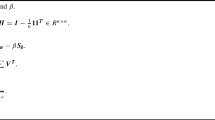Abstract
In machine learning, the quality of the acquired features significantly influences the accuracy of the target task. Recently, use of large-scale data has expanded in various fields. Large-scale data generally contains much information. Furthermore, machine learning makes it challenging to extract independent features from them. Furthermore, if the extracted features have a lot of redundancy, the learning results cannot obtain sufficient performance. This study reduces the redundancy of the acquired features and realizes intuitive mapping to latent space according to the information of the data. The proposed method has two learning steps. Initially, we create a feature extractor with sufficient performance for a particular data type. Then, the second step creates another feature extractor. Here, we learn that the features acquired by the extractor are independent of the features acquired in the first step. The experiment extracted features from the data based on the collaboration of two feature extractors. The first extractor extracts many common features, and the second extractor realizes feature extraction according to the individuality of the data. Then, we succeeded in mapping data groups with different characteristics to different regions of the latent space.
Access this chapter
Tax calculation will be finalised at checkout
Purchases are for personal use only
Similar content being viewed by others
References
Goodfellow, I., Pouget-Abadie, J., Mirza, M., Xu, B., Warde-Farley, D., Ozair, S., Courville, A., Bengio, Y.: Generative adversarial nets. In: NIPS (2014)
Radford, A., Metz, L., Chintala, S.: Unsupervised representation learning with deep convolutional generative adversarial networks. In: ICLR (2016)
Chen, X., Duan, Y., Houthooft, R., Schulman, J., Sutskever, I., Abbeel, P.: Infogan: interpretable representation learning by information maximizing generative adversarial nets. In: NIPS (2016)
Author information
Authors and Affiliations
Corresponding author
Editor information
Editors and Affiliations
Rights and permissions
Copyright information
© 2023 The Author(s), under exclusive license to Springer Nature Switzerland AG
About this paper
Cite this paper
Ikezumi, Y., Seo, M. (2023). Acquisition of Highly Independent Latent Space for Distribution Control Based on Features. In: Omatu, S., Mehmood, R., Sitek, P., Cicerone, S., Rodríguez, S. (eds) Distributed Computing and Artificial Intelligence, 19th International Conference. DCAI 2022. Lecture Notes in Networks and Systems, vol 583. Springer, Cham. https://doi.org/10.1007/978-3-031-20859-1_5
Download citation
DOI: https://doi.org/10.1007/978-3-031-20859-1_5
Published:
Publisher Name: Springer, Cham
Print ISBN: 978-3-031-20858-4
Online ISBN: 978-3-031-20859-1
eBook Packages: Intelligent Technologies and RoboticsIntelligent Technologies and Robotics (R0)




